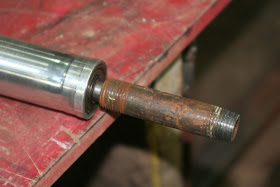So somehow I got sucked into building a deck for my boss even though I have vowed to take a break after completing the 14' x 20' shed I built for some other people I know. Anyways, I was preparing the tools and going through the process in my mind wondering how I'm going to consolidate the concrete and make it air bubble free since the deck needs twelve 8" concrete posts, 4'-6" into the ground and hitting it on the side with a hammer (which I normally do to get the air bubbles out and the surface nice and smooth), since it will be several feet in the ground I won't be able to do it, so I got an idea that I could try to build my own concrete vibrator.
From Wikipedia:
Concrete vibrators consolidate freshly poured concrete so that trapped air and excess water are released and the concrete settles firmly in place in the form work. Improper consolidation of concrete can cause product defects, compromise the concrete strength, and produce surface blemishes such as bug holes and honeycombing. An internal concrete vibrator is a steel cylinder about the size of the handle of a baseball bat, with a hose or electrical cord attached to one end. The vibrator head is immersed in the wet concrete
Process:
It was about 9PM when I headed out to the shop trying to find some materials to build the vibrator when I walked past our old, dead tread mill in the garage. Looking at the roller the belt runs on I thought I might be able to make it work.
The roller is about an inch and a quarter diameter, with a half-inch stainless steel core held in place by two bearings, one on each side. Pretty basic set-up. I managed to take the center core steel rod out, grind it flat and weld a 3/8" by 3/8" square solid steel rod to it. Then I took the grinder and ground off some more materials of the center rod opposite the square steel rod to make the rod off-weight.
Once it was welded, I placed it back into the aluminum roller, attached it to a 25ft. plumbing snake and enclosed the whole thing in some ABS pipe and water hose.
Pictures:
 The original roller
The original roller Close-up
Close-up Another close-up
Another close-up With the square steel rod welded to the center core
With the square steel rod welded to the center core A close-up of the opposite side that was ground off to make it more off-balance
A close-up of the opposite side that was ground off to make it more off-balance Cut off one end of the rod that was sticking out
Cut off one end of the rod that was sticking out Steel nipple as an adapter to connect center rod with plumbing snake
Steel nipple as an adapter to connect center rod with plumbing snake Steel nipple on the end of the roller
Steel nipple on the end of the roller Finished DIY concrete vibrator
Finished DIY concrete vibrator This is where the drill will attach
This is where the drill will attach Actual concrete vibrator head
Actual concrete vibrator headTools:
Alan keys
Cordless drill
Snap-ring pliers
Grinder
Welder
Goggles
Ear muffs
Screw driver
Drill
Materials:
Old treadmill roller (free)
16" of 3/8" by 3/8" square steel rod (free)
4" by 3/4" pipe nipple (free)
25' plumbing snake ($14.95)
20" of 1.5" ABS pipe (free)
ABS cap ($2.49)
ABS reducer ($2.59)
ABS connector ($0.67)
Water hose adapter ($0.54)
Water hose clamp (free)
20 feet of 3/4" water hose (free)
Cost:
$24.00
Time:
2.5 hrs
Savings:
$275.00
Conclusion:
I'll update the blog once I've finished pouring the posts.
I like your approach:
ReplyDelete1. how did you attach flexible plumbing snake to pipe nipple?
2. what size is abs pipe for roller ?
3. how did original vibrator work out?
dear anonymous, I can't remember 100% about your #1 question but I think I used the existing plumbing snake end (the one that looks like a spiral) and threaded it either over the nipple or into the nipple and then drilled and tapped a small hole in the end and used a bolt to prevent it from loosening. as for #2, it's a regular 1-1/2" pipe and as for #3, it works out really well for smaller jobs such as post holes, and up to 12" sonotubes. hope this helps.
ReplyDeleteNice writeup. What type of drill did you use? I am wondering how I can usemy rotorary hammer for a project like this.
ReplyDeleteI used my 1/2" hammer drill but a regular 3/8 drill would work just as fine.
ReplyDeleteOr try a real vibrator from the wife's drawer, ok cut off the plastic rubber from it,then vibrate away.
ReplyDeleteFunny, maybe my wife would like the homemade one.?
ReplyDeleteGreat idea using a plumping snake for the flexible extension. My opinion you used too much offset weight and not focused on the rpm. Commercial vibrators turn quite fast at several thousand rpm to create a high frequency vibration rather than a slower violent motion.
ReplyDeleteMy opinion be to use a high speed 3/8 in. drill for the power because 1/2 in. drills generally turn slower rpm.
Using higher frequency of turn and vibration, less offset weight could be used. The bearings and housing components would last longer. A weak point would be where the snake attaches the vibrator. Eventually it would break from fatigue induced by vibrations. If one can come up with some type of rubberized dampening connector in between, I think it would make a big difference.
so now im thinking of placing the old dremel into a sealed pipe with off set weighted bit, 2 or 3 foot pipe as im pouring footers and slab
ReplyDelete